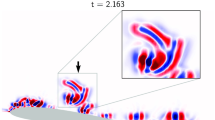Abstract
The recently developed essentially fourth-order or higher low dissipative shock-capturing scheme of Yee, Sandham, and Djomehri [25] aimed at minimizing numerical dissipations for high speed compressible viscous flows containing shocks, shears and turbulence. To detect non-smooth behavior and control the amount of numerical dissipation to be added, Yee et al. employed an artificial compression method (ACM) of Harten [4] but utilize it in an entirely different context than Harten originally intended. The ACM sensor consists of two tuning parameters and is highly physical problem dependent. To minimize the tuning of parameters and physical problem dependence, new sensors with improved detection properties are proposed. The new sensors are derived from utilizing appropriate non-orthogonal wavelet basis functions and they can be used to completely switch off the extra numerical dissipation outside shock layers. The non-dissipative spatial base scheme of arbitrarily high order of accuracy can be maintained without compromising its stability at all parts of the domain where the solution is smooth. Two types of redundant non-orthogonal wavelet basis functions are considered. One is the B-spline wavelet (Mallat and Zhong [14]) used by Gerritsen and Olsson [3] in an adaptive mesh refinement method, to determine regions where refinement should be done. The other is the modification of the multiresolution method of Harten [5] by converting it to a new, redundant, non-orthogonal wavelet. The wavelet sensor is then obtained by computing the estimated Lipschitz exponent of a chosen physical quantity (or vector) to be sensed on a chosen wavelet basis function. Both wavelet sensors can be viewed as dual purpose adaptive methods leading to dynamic numerical dissipation control and improved grid adaptation indicators. Consequently, they are useful not only for shock-turbulence computations but also for computational aeroacoustics and numerical combustion. In addition, these sensors are scheme independent and can be stand-alone options for numerical algorithms other than the Yee et al. scheme.
Similar content being viewed by others
REFERENCES
Daubechies, I. (1992). Ten Lectures on Wavelets, CBMS-NSF regional conference series in applied mathematics, No. 61, SIAM.
Farge, M. (1992). Wavelet transforms and their applications to turbulence. Ann. Rev. of Fluid Mech. 24, 395–457.
Gerritsen, M., and Olsson, P. (1996). Designing an efficient solution strategy for fluid flows. J. Comput. Phys. 129, 245–262.
Harten, A. (1978). The artificial compression method for computation of shocks and contact discontinuities: III self-adjusting hybrid schemes. Math. Comp. 32, 363–389.
Harten, A. (1995). Multiresolution algorithms for the numerical solution of hyperbolic conservation laws. Comm. Pure Appl. Math. 48, 1305–1342.
Harten, A., and Hyman, J. (1983). Self-adjusting grid methods for one-dimensional hyperbolic conservation laws. J. Comput. Phys. 50, 235–269.
Jiang, G., and Shu, C.-W. (1996). Efficient implementation of weighted ENO schemes. J. Comput. Phys. 126, 202–228.
LeVeque, R. J., and Yee, H. C. (1990). A study of numerical methods for hyperbolic conservation laws with stiff source terms. J. Comput. Phys. 86, 187–210.
Mallat, S. G. (1999). A Wavelet Tour of Signal Processing, 2nd ed., Academic Press, San Diego.
Mallat, S. G. (1989). Multifrequency channel decompositions of images and wavelet models. IEEE Trans. Acoust. Speech Signal Process. 37, 2091–2110.
Mallat, S. G. (1989). Multiresolution approximations and wavelet orthonormal bases of L2(R). Trans. Amer. Math. Soc. 315, 69–87.
Mallat, S. G. (1989). A theory for multiresolution signal decomposition: The wavelet representation. IEEE Trans. Patt. Anal. Mach. Intell. 11, 674–693.
Mallat, S. G., and Hwang, W. L. (1992). Singularity detection and processing with wavelets. IEEE Transactions on Information Theory 38, 617–643.
Mallat, S. G., and Zhong, S. (1992). Characterization of signals from multiscale edges. IEEE Transactions on Pattern Analysis and Machine Intelligence 14, 710–732.
Minh, D.-K., Basdevant, C., Perrier, V., and Khoa, D.-T. (1994). Wavelet analysis of 2-D turbulent fields, Physica D 76, 252–277.
Perrier, V., Philipovitch, T., and Basdevant, C. (1999). Wavelet Spectra Compared to Fourier Spectra, Publication of ENS, Paris.
Roe, P. L. (1981). Approximate Riemann solvers, parameter vectors, and difference schemes. J. Comput. Phys. 43, 357–372.
Sandham, N. D., and Yee, H. C. (2000). Entropy Splitting for High Order Numerical Simulation of Compressible Turbulence, RIACS Technical Report 00.10, June 2000, NASA Ames Research Center; Proceedings of the first international conference on CFD, July 10–14, 2000, Kyoto, Japan.
Sjögreen, B. (1995). Numerical experiments with the multiresolution scheme for the compressible euler equations. J. Comput. Phys. 117, 251–261.
<bib-other>Sjögreen, B., and Yee, H. C. (2002). Analysis of High Order Difference Methods for Multiscale Complex Compressible Flows, Proceedings of the ninth international conference on hyperbolic problems, March 25–29, 2002, Pasadena, California.
Strang, G. (1989). Wavelet and dilation equations: A brief introduction. SIAM Rev. 31, 614–627.
Strang, G. (1993). Wavelet transforms versus fourier transforms. Bull. Amer. Math. Soc. (N.S.) 28, 288–305.
Yee, H. C. (1987). Upwind and Symmetric Shock-Capturing Schemes, NASA TM-89464, May 1987.
Yee, H. C. (1989). A Class of High-Resolution Explicit and Implicit Shock-Capturing Methods, VKI lecture series 1989-04, March 6–10, 1989, also NASA TM-101088, Feb. 1989.
Yee, H. C., Sandham, N. D., and Djomehri, M. J. (1999). Low dissipative high order shock-capturing methods using characteristic-based filters. J. Comput. Phys. 150, 199–238.
Yee, H. C., and Sjögreen, B. (2001). Adaptive Numerical Dissipation Control for High Order Methods, Proceedings of the 3rd internat. AFOSR conf. on DNS and LES, Arlington, Texas, August 5–9, 2001.
Yee, H. C., Vinokur, M., and Djomehri, M. J. (2000). Entropy Splitting and Numerical Dissipation, NASA technical memorandum 208793, August, 1999, NASA Ames Research Center; Yee, H. C., Vinokur, M., and Djomehri, M. J. (2000) J. Comput. Phys. 162, 33-81.
Yee, H. C., Sjögreen, B., Sandham, N. D., and Hadjadj, A. (2000). Progress in the Development of a Class of Efficient Low Dissipative High Order Shock-Capturing Methods, RIACS Technical Report 00.11, June, 2000; Proceedings of the CFD for the 21st Century, July 15–17, 2000 Kyoto, Japan.
Author information
Authors and Affiliations
Rights and permissions
About this article
Cite this article
Sjögreen, B., Yee, H.C. Multiresolution Wavelet Based Adaptive Numerical Dissipation Control for High Order Methods. Journal of Scientific Computing 20, 211–255 (2004). https://doi.org/10.1023/B:JOMP.0000008721.30071.e4
Issue Date:
DOI: https://doi.org/10.1023/B:JOMP.0000008721.30071.e4




